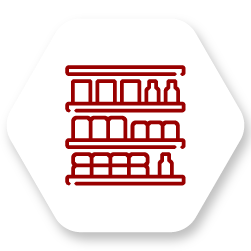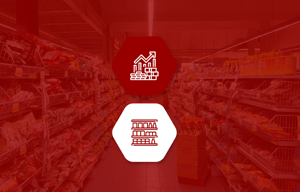Effective stock management is a critical process for your business as it allows you to have the right products at the right time and in the right place. Fail to manage your inventory, and you will bear the consequences, many of which will possibly lead to a loss in sales and profits. Fortunately, data-driven planograms are a solution.

What is stock management?
Stock management is defined as the process of ordering, storing, tracking and monitoring your stock or inventory levels. That is why you can also refer to this as inventory management.
Let us look at it this way. As mentioned above, it is a critical process for you to master. It allows you to carry the right merchandise that your customers want at the right time and place. At the same time, it is about having the right balance of products - neither too little nor too much stock.
By managing your stock correctly, you can look forward to lower costs, increased profits and greater insight into sales patterns. Meanwhile, poor stock management leads to the opposite.
Consequences include increased inventory costs, and capital caught up in inventory value, increased out of stocks, reduced profit margins, higher rates of spoilage and obsolescence (dead stock), complicated processes, slower growth, decreased customer satisfaction and the inability to forecast.
Here is an example to explain it further. Let us say you are a food retailer, so you are highly sensitive to the amount of stock you can keep and for how long. Many if not all of your products have a limited time that you can keep them in storage or on the shelf before they expire. If you have too much stock on hand, your items will perish or expire before they are sold, which means lost sales.
But it's not just about you, the retailer.
By not managing your inventory, you are also opening the door to dissatisfied and frustrated customers. When done poorly, it can lead to delays in shipments of products to your store, resulting in your customers not finding the products they want, forcing them to visit your competitors, both direct and indirect, to fulfil their needs. That leads to decreased customer loyalty and financial losses. On the contrary, if you have an excess of stock, this will also lead to financial losses.
The cost of not managing your stock effectively in the short term is a loss of profits. Long-term, it can mean the loss of your business. Therefore, as dramatic as it might seem, failing to invest in proper stock management solutions can cost your company its entire existence. That's a reality.

Why are data-driven planograms critical for effective stock management?
1. You can use planograms to ensure consistent days of supply
Days of Supply or DOS refers to how many days it will take for a particular product to sell out with its current space allocation. That is if sales continue at the same rate as recent sales. It is also often evaluated against a 30, 60 or 90 day time period.
When creating data-driven planograms, the goal is to achieve an even DOS for all products while considering various factors. Let us use the food retailer example again here. In aligning your DOS, you ensure that you sell your perishable items before they expire.
At the same time, you can maintain a visually appealing gondola with no empty shelves. This not only assists with more consistent shelf replenishment but also ensures you do not have too much slow-moving stock or too little stock of fast-selling items.
Well-designed planograms also ensure that any shelf replenishment exercise does not happen randomly and continuously. Instead, you can restock your shelves at regular intervals.
Data-driven planograms enable you to not only see the DOS for a single product on a single facing. They also allow you to adjust the facings (and thus the capacity).
If we balance out the facings and the DOS, it will indicate the capacity, which, in turn, will aid in minimum order quantities. By preventing stockouts, optimising stock rotation and increasing inventory control, consistent DOS makes the shelf replenishment cycle easier.
2. You can use planograms to ensure products get the correct amount of space
When building out data-driven planograms, it is critical to analyse your sales data continuously to ensure products get the right amount of space.
For example, if the demand for a certain product suddenly increases and the buyer of the category places a larger order, you can give the product more facings. You can even place it in a better position on the shelf to ensure customers can easily find the item.
If there was a lack of proper analysis, the products would have remained where they were. They also would not be given more space and your store would not have taken full advantage of the sales potential. This would have made it harder for your customers to find the item, resulting in loss of sales and negatively affecting shelf replenishment as stock of this product would have sold out much faster.
The use of custom graphs, highlighting spectrums and product information such as procurement, DOS, and weekly units sold, available in specialised software can assist you to give products the space they deserve on the shelf.
Interested in testing out DotActiv software? Try a 14-day free trial of any software edition
For example, with the Highlighting tool in DotActiv, you can establish whether or not to discontinue a slow-selling item. That allows you to free up space for the products that deserve it.
For some categories, you do need to take other factors into account when completing planograms. That includes supplier agreements, which refers to set, paid space that a supplier’s brand must receive. Other factors are house brands. When completing planograms, one of your objectives might be to grow your house brand. In that case, you could look to give more space to these products.
Not only can data-driven planograms ensure products receive the space they deserve, but they can also reflect data-driven tactics to improve the performance and efficiency of your shelf space while taking advantage of potential growth opportunities.
3. You can use planograms to execute your chosen merchandising strategy
Merchandising principles act as a guide to placing your products on the shelf, thereby making your store easier to shop and your shelves visually appealing to customers. It will also aid in ensuring consistency across all of your stores or establishments and improve customer loyalty, which ultimately drives sales growth.
Correct merchandising principles will also help you keep the flow of your products organised and avoid congestion.
For example, by placing fast-sellers or key valued items at eye level or including a minimum amount of products on the shelf for faster-moving products, you can avoid out of stocks.
Another example is to place house brands next to brand leaders to create a sense of value and help drive sales of these items. Cross-merchandising specific products across your store can also assist in exposing customers to these lines, which can lead to impulse purchases and larger basket sizes.
Once you have chosen your merchandising strategy and set principles, you can determine the layout and establish the exact capacities of products. With this information, you can order the correct stock. Data-driven planograms, therefore, directly assist in stock management.
By determining the layouts, you can ensure consistency throughout all of your stores. Your customers will also know where to find products and find what they need no matter which of your stores they visit.
By applying specific merchandising principles to each category, you can also ensure that you always place products on the shelf in a logical, visually appealing and profitable way. Again, that leads to a reduction in out of stocks and better shelf replenishment.
4. You can use planograms to ensure you have the right assortment
Data-driven planograms allow you to determine the correct product assortment with the fastest unit movement and highest sales turnover. That also allows you to spot trends of consumer behaviour which can assist in forecasting.
By analysing the data of your current ranges, you can determine which of your products are slow-movers. You can look to discontinue these items. Then you can also look at the products that you need to add to the ranges. That includes, for example, innovation lines or seasonal items for Christmas, back-to-school, Valentine's Day and so on.
Before selecting your product assortment, you will need to understand the consumer decision tree and implement a category role.
The consumer decision tree allows you to understand how customers shop a category, essentially explaining their buying habits. Your category role determines how it meets the needs of your customers. When selecting your product assortments, it is crucial to have a base range in all stores. From there, you can tailor the range to specific stores to meet varying customer demands.
For example, moisture absorbers might sell better in coastal stores than inland stores due to higher humidity in these regions. Of course, you do need to look at your data to confirm any buying trends.
By analysing your data, you can fulfil the needs of your customers by stocking the right products. That leads to customer satisfaction. Meanwhile, you (and your suppliers) can benefit from the increase in sales and profit. It’s a win-win for everyone.
Conclusion
Data-driven planograms are a great solution to effectively manage stock by balancing DOS of products, ensuring that all products get the right space, implementing correct merchandising strategies and selecting the right assortment.
Are you looking for a solution to help you manage your stock in-store? You can book a complimentary custom exploratory consultation with us here or visit our online store.


